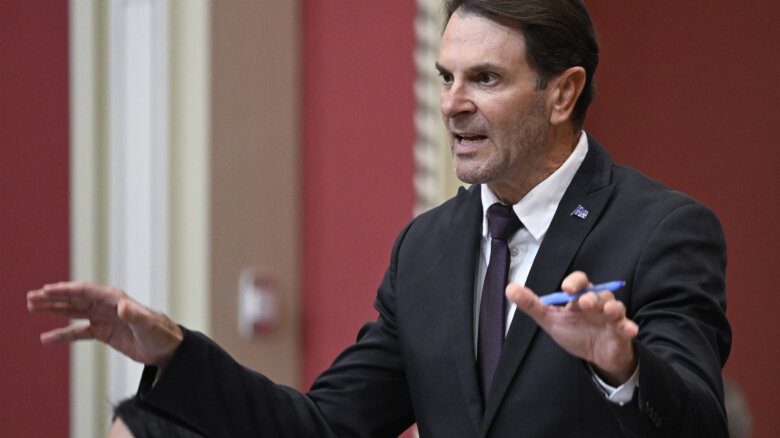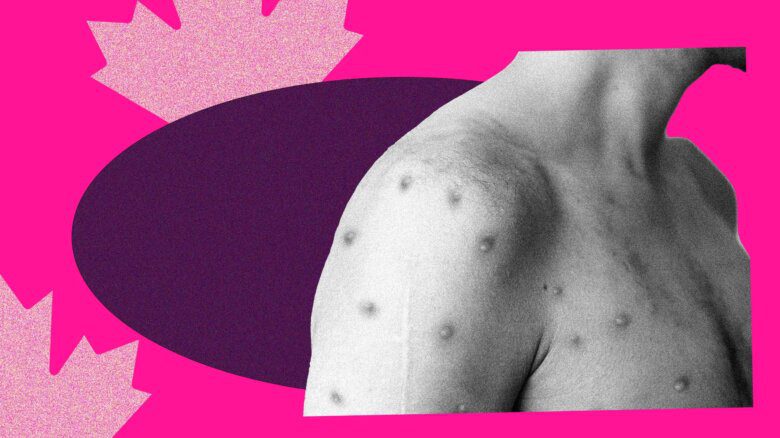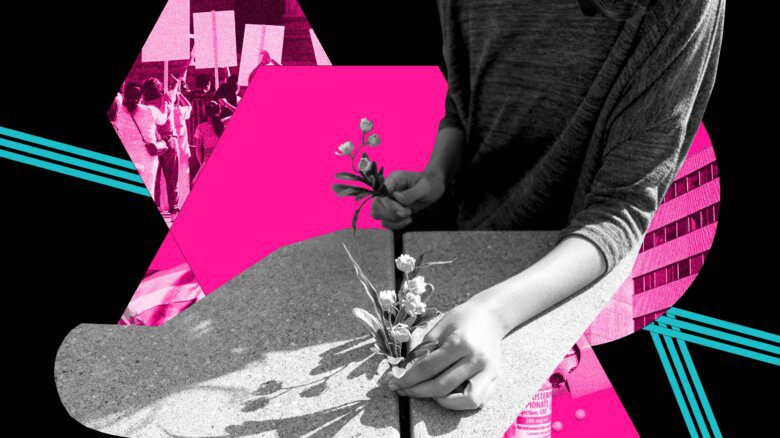In the fall of 2015, Catherine Robertson lay in a bed at Calgary’s Foothills Medical Centre, her body so broken she could hardly move an inch without help. While paragliding in Colombia, the then-61-year-old crashed into some power lines, and suffered a crushed pelvis, broken vertebrae and ribs, a concussion and nerve damage.
As is common with serious accidents, it was a brutal reminder of how short and fragile life is. It also raised a very pressing question: up until that point, Robertson had been living as a man, dressing and presenting as Catherine only in private or occasionally at gay bars. “When I was there laying on my broken back, I realized I lived the last 61 years as a lie,” she says. She asked herself if she was willing to do that for the next 60 — the answer was no.
Like many LGBTQ2 people of her generation, Robertson had been told throughout her life, both implicitly and explicitly, that her identity was wrong, something to be kept hidden. After the accident, she decided to live fully as Catherine, the person she’s known to be her true self since she was five.
“One of the advantages of waiting until you’re in your 60s to do it is you’ve got a little life experience,” she says. Robertson still lives in the house she custom designed in the Calgary suburb of Cochrane. Though coming out led to the breakdown of her marriage, she and her former spouse remain close. She has a sprawling network of supportive friends she’s made through her many hobbies, like woodworking and archery. She also attends a bi-monthly support group called TransJourneys.
But, like many seniors, Robertson has concerns about the future. Though losing some mobility is a normal part of aging, the injuries she sustained in the accident have made that issue more prevalent — and in a large, multi-level home like hers, it could pose a problem later on. Though she says healthcare professionals have been accepting and supportive thus far, navigating the many doctors’ appointments and recovering in her own home without a full-time partner or caregiver can be difficult at times.
Robertson wonders: how will she age in the home she loves? And if she can’t, how will she stay connected to the many neighbourhood communities she belongs to?

Canada is facing a “grey wave” — a rapidly growing number of seniors whose needs for housing and social services are swelling above available resources. Alberta alone is expected to have more than 1.1 million seniors by 2040, about 18 percent of the province’s population; nationally, the senior population is projected to be between 23 and 25 percent by 2036.
Within this cohort are an increasing number of seniors from LGBTQ2 communities who have witnessed a pivotal change in queer and trans rights in Canada. As a 2015 report on housing from Ottawa’s Senior Pride Network notes: “LGBT seniors have lived through an era when homosexuality was considered a mental illness by the medical/psychiatric profession; a criminal offence by the justice system and a sin by established religion . . . In this environment it was safer to ‘stay in the closet’ than come out publicly and possibly risk losing their job, family, friends, housing and relationships. The HIV/AIDS crisis of the 1980s only added to gay men’s risk of being shamed/judged and further isolated.”
“The voices of LGBTQ2 seniors have been neglected in the national conversation on how best to support our aging population”
Robertson knows this firsthand. One of the first times her identity was met with fear and dismissal was in Grade 3, when her class was asked to write about whether being a boy or girl was better. Robertson wrote in favour of being a girl, because that was what came naturally to her — it was a reflection of how she felt inside. Her teacher balked and alerted her parents. “You don’t write a story like that in 1962 in British Columbia — you just don’t. The hoopla, the furor that caused . . . was just mind boggling,” she says.
To come out five decades later, Robertson now knows, was a much safer bet.
The impact of generational experiences have created challenges unique to this cohort, even those who have found the kind of acceptance that Robertson has. The Ottawa report goes on to say that many LGBTQ2 seniors keep their sexual orientation or gender identity to themselves out of a lingering fear of discrimination and mistrust of healthcare professionals.
One of the areas in which this is most prevalent is housing. Recent coverage from across the country has suggested that LGBTQ2 seniors have to “go back into the closet” as they enter long-term care facilities, where they face fear, bullying and exclusion from fellow residents and by caregivers. A study conducted by the Calgary-based research group Habitus, for which Robertson served as a peer researcher, states as much: “There is uncertainty about whether processes are in place to protect human rights.”
Similar studies have been conducted or proposed in cities like Edmonton, Toronto, Winnipeg and Ottawa. Their conclusion: while most seniors would prefer to age in place, their main desire is to know that wherever they go, they’ll be safe and accepted — and will continue to feel connected to their communities.
It sounds simple. But the housing issue reveals that the voices of LGBTQ2 seniors have been neglected in the national conversation on how best to support our aging population. As an ever-growing number of seniors face questions about their long-term health and care, many, like Robertson, find themselves facing uncertainty when it comes to how and where they’ll age, and who will be by their sides while they do.

The breakfast shift is barely underway at the Denny’s near Rocky Wallbaum’s home in suburban Calgary, but he’s already been up for a couple of hours. He’s an early riser, both by nature and because his busy schedule often demands it — even though he’s retired, his volunteer and social commitments sometimes keep him busier than when he worked. Dressed in a beige knit sweater adorned with a Pride flag pin, he has an easygoing, enthusiastic demeanour that speaks to his many years as an activist, community leader and former college instructor.
Now 62, Wallbaum has been involved in LGBTQ2 seniors’ issues since he moved to Calgary nearly a decade ago and, like Robertson, was also a peer researcher with the Habitus study. In November 2017, he co-founded the group Rainbow Elders after years of hearing from community members that spaces for seniors were lacking.
Rainbow Elders began as a discussion group and vehicle for social gatherings and events. “After about the third or fourth meeting, the facilitator asked, ‘What brings you back?’ and a lot of people said, ‘As a senior, I want to visit with people of my vintage. I don’t want to have to go to the bar just to socialize. When I tell people what’s going on, they actually listen to me,’” Wallbaum says.
Now Rainbow Elders has become the go-to resource for LGBTQ2 seniors in the Calgary area, and it is in the process of becoming a designated society so that they can receive steady funding and expand their profile. There are currently about 15 members, and meetings are relatively informal, centred around a group discussion. Wallbaum says a facilitator will start by asking broad questions like, “What’s coming up for you?” or “What’s been going on in your life recently?” and a conversation will progress from there.
Wallbaum says housing comes up a lot, and the group pools resources and information when they can. But he also raises the question of how to help those aging in place — which, as studies have found, will be the majority of LGBTQ2 seniors — feel connected. “Maybe it’s about calling the community centre nearby and saying, ‘What are you doing for LGBTQ2 folks?’”
“When a population of seniors is additionally marginalized, that can further strain community ties”
But when it comes to building spaces for LGBTQ2 seniors, there are unique challenges that depend on the size, location and history of the community. Pam Krause, the president and CEO of Calgary’s Centre for Sexuality, uses the city as an example: she says it has always struggled to form strong LGBTQ2 communities. In part, that’s because Calgary’s downtown is relatively small and spread out, making it difficult to build an identifiable community hub. Calgary also has a long history of being a conservative stronghold in Alberta, especially during the years when the government in power was either unsupportive of, or openly against, LGBTQ2 rights. Krause, who’s in her 60s, remembers it clearly. “People just didn’t feel safe to come out,” she says.
Krause points to another compounding factor: social isolation, which she says is a major risk factor for all seniors. When a population of seniors is additionally marginalized, that can further strain community ties. This means that some LGBTQ2 seniors may be entering facilities from a comfortable environment in which they were out and felt safe, and suddenly wind up in close quarters with homophobic residents or caregivers with whom they may have otherwise rarely crossed paths.
Wallbaum says the basic structure of care facilities creates the grounds for bullying and homophobia. “When you’re in high school, there are always some bullies around, because you’ve got a closed community with a lot of supervisory control but also a lot of freedom,” he says. “When you’re in a seniors’ community, there’s still supervision but, again, it’s closed . . . so there’s a lot of subtle and not-so-subtle bullying that goes on.”

At the corner of Sherbourne and Wellesley, on the edge of Toronto’s gay village, there’s a plain brick building, not so different from many of the apartment complexes in the area. Inside you will find a mix of residents, staff and a large roster of volunteers, all of whom have made the space open to LGBTQ2 seniors. This is Fudger House, one of the few LGBTQ2-centric long-term care homes in Canada.
The concept of LGBTQ2-only seniors’ homes has been raised in some research as a potential solution to the issues queer seniors are facing, and Fudger House is an active example. Aggie Fortier, a representative for the City of Toronto, clarifies that while Fudger House is better known because of its close proximity to the Village, “all ten City-run homes are LGBTQ2-friendly.” Fortier says that Toronto’s long-term care homes have had an official toolkit in place since 2008 that provides a strategy for competent care for LGBTQ2 residents.
Fudger House takes an active role in Pride festivities, and volunteers help organize social gatherings to get residents involved in community activities — all of which contributes to an open, affirming environment. “When I came to Fudger House I felt I could be myself,” says Alf Roberts, a current resident. “I never fully ‘came out’ until I was 80 years old and living [here].”
A number of reports about LGBTQ2 seniors and housing say it’s important to consider that many seniors may have come out much later in life, or may still not even be out, and as a result could be estranged from their family and dealing with mental health challenges. “For some of us, secrecy is still very important,” one respondent in Calgary’s Habitus study said.
This is one reason Krause says it’s more beneficial to work on making existing spaces open and inclusive rather than to push for LGBTQ2-exclusive homes. “Where we need to be is: as a person from a marginalized community, I should not have to ask for what I need — it should be there for me when I walk in the door,” she says. “And it’s the job of everybody to figure out what those needs are, which are often universal.”
“LGBTQ2 seniors who get involved in their community ‘can overcome isolation and often have better self-esteem and health’”
LGBTQ2-specific training for those working with seniors is one place to start. Over the past decade, Calgary’s Centre for Sexuality has trained more than 15,000 workers on how to provide appropriate care for LGBTQ2 seniors, and how to intervene when residents exhibit bullying behaviour, like using offensive language or purposely excluding someone from activities or social gatherings. Training includes workshops that address basic questions about LGBTQ2 communities, and a full guide that seniors’ homes and organizations can use to audit their policies from the top down.
The initiative of groups like Rainbow Elders has helped bring LGBTQ2 seniors’ voices into the larger conversation on housing, care and aging. A research review published by Hamilton’s McMaster University last spring speaks to the efficacy of these types of networks, noting that LGBTQ2 seniors who get involved in their community “can overcome isolation and often have better self-esteem and health.” The study also reaffirms the importance of training for those working with seniors, noting that it “may help [seniors] to remain healthy, active and engaged as long as possible.”
Though seniors have seen landmark advancements in LGBTQ2 rights in Canada, they’ve also lived through some of the most difficult and shameful events in recent history. This brings into sharp focus how traumatizing the idea of having to “go back into the closet” or feeling isolated is for a generation that has already survived so much hardship. Calgary’s example shows that even within urban centres, there is still work to be done to create active spaces for LGBTQ2 seniors.
In an ageist society, Rocky Wallbaum says it’s about encouraging people to take pride in their knowledge and lived experiences. It sounds simple, but he has seen the impact of these small changes firsthand. He recalls how, early on, more than half of Rainbow Elders members shied away when asked to be part of a group photo for their Facebook page, too worried about being associated online with an LGBTQ2 group. A few months later, when the group was offered a spot in Calgary’s Pride Parade, Wallbaum says every single member marched. “What it’s done for the people in our group has been special,” he says. “We are connected.”

As she moves toward a full recovery from her accident, Catherine Robertson’s goal is to keep nurturing her diverse hobbies. She’s also hoping to get back to paragliding soon.
Even with her various support networks, Robertson says that coming out as trans can still be “a lonely path.” But she knows that people can be full of surprises. The first time she showed up to her Woodturner’s Association meeting as Catherine, some of her peers (who are mostly men in their 60s) came up to her privately and said, “If anyone gives you any grief, you come and get me.”
In a society that tends to erase the idea of a dynamic life for seniors, Robertson’s biggest fear is being restricted by labels; of being put into a box and filed away rather than acknowledged for the multifaceted person she is. In the end, her philosophy is simple: “Anything that stops any person from being the best person they can be is wrong.”



 Why you can trust Xtra
Why you can trust Xtra


